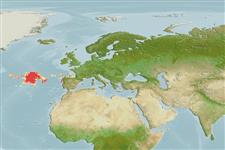Elasmobranchii (tubarões e raias) (sharks and rays) >
Rajiformes (Skates and rays) >
Arhynchobatidae (Softnose skates)
Etymology: Bathyraja: Greek, bathys = deep + Latin, raja, -ae = a ray (Raja sp) (Ref. 45335).
Environment: milieu / climate zone / depth range / distribution range
Ecologia
marinhas batidemersal; intervalo de profundidade 2400 - 2950 m (Ref. 3167). Deep-water; 47°N -
Northeast Atlantic: known from 3 specimens from the northern Bay of Biscay but distribution no doubt wider.
Tamanho / Peso / Idade
Maturity: Lm ? range ? - ? cm
Max length : 160 cm TL macho/indeterminado; (Ref. 3167)
A very rare species found on lower parts of continental slope and on adjacent deep-sea plains (Ref. 3167). Oviparous (Ref. 50449). Eggs have horn-like projections on the shell (Ref. 205).
Ciclo de vida ou comportamento de acasalamento
Maturidade | Reprodução | Desova | Ovos | Fecundidade | Larvas
Oviparous (Ref. 3167). Paired eggs are laid. Embryos feed solely on yolk (Ref. 50449). Eggs have horn-like projections on the shell (Ref. 205).
McEachran, J.D. and K.A. Dunn, 1998. Phylogenetic analysis of skates, a morphologically conservative clade of elasmobranchs (Chondrichthyes: Rajidae). Copeia 1998(2):271-290. (Ref. 27314)
Status na Lista Vermelha da UICN (Ref. 130435: Version 2024-1)
Ameaça para os humanos
Harmless
Uso pelos humanos
Pescarias: sem interesse
Ferramentas
Relatórios especiais
Baixar XML
Fontes da internet
Estimates based on models
Índice de diversidade filogenética (Ref.
82804): PD
50 = 0.5000 [Uniqueness, from 0.5 = low to 2.0 = high].
Bayesian length-weight: a=0.00550 (0.00291 - 0.01038), b=3.13 (2.97 - 3.29), in cm total length, based on LWR estimates for this Genus-body shape (Ref.
93245).
Nível Trófico (Ref.
69278): 3.6 ±0.50 se; based on food items.
Resiliência (Ref.
120179): Baixo, tempo mínimo de duplicação da população 4,5 - 14 anos (Fec assumed to be <100).
Fishing Vulnerability (Ref.
59153): Very high vulnerability (90 of 100).
Nutrients (Ref.
124155): Calcium = 2.51 [0.35, 50.64] mg/100g; Iron = 0.244 [0.023, 3.282] mg/100g; Protein = 14.1 [12.3, 16.1] %; Omega3 = 0.375 [0.141, 0.985] g/100g; Selenium = 24.8 [4.2, 110.9] μg/100g; VitaminA = 3.62 [0.24, 50.82] μg/100g; Zinc = 0.261 [0.017, 3.236] mg/100g (wet weight);
